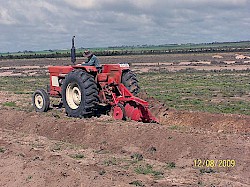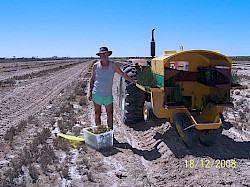Traditional forestry methods, for the provision of moisture
In order to establish successful plantations in Western Australia, forestry is normally restricted to areas that receive more than 400mm rainfall per annum. And the tradition is to plant trees with the winter rains – that is May to August.
Other than those who elect to water their trees – at great expense – there is no other method used to provide trees with additional water.
However, with the arrival of the winter rains, highly opportunistic and competitive weeds germinate, shade and out-compete young trees that are planted at this time, for moisture and nutrients. To counter this competition, the practice is to apply ‘knock-down’, ‘pre-emergent’ and ‘post-emergent’ herbicides. This obviously incurs costs in purchasing and applying the herbicides. The theory is that by eliminating competition by weeds, more moisture will be available for the trees. But will it?
While it is open to debate, I suggest that the weeds provide a considerable amount of moisture, by harvesting condensation at night and funneling it deep into the soil, which they shade, reducing evaporation. I suspect that the ‘competition’ they are said to provide, is more a case of them having allopathic relationships with the trees. It is well-recognized that many plants have the capacity to kill off or suppress the growth of their competitors, by excreting chemical compounds into the surrounding soil.
'Auria' methods for the provision of moisture
Various methods have been developed at ‘Auria’, to make more moisture available to the trees. Vast quantities of water are wasted in agricultural regions, purely as a result of surface-water-flow, flooding is clear evidence that this is occurring. Water must be retained high in the landscape.
Vast quantities of water are wasted in agricultural regions, purely as a result of surface-water-flow, flooding is clear evidence that this is occurring. Water must be retained high in the landscape.
Thus the concept is to plant belts of trees at regular intervals, commencing at the highest point. Distance between the belts is determined, based on the steepness of the slopes and the intensity of rainfall events that have been observed in the area. If the ground is properly prepared, having intercepted any surface-water-flow, the belts of trees will encourage it to infiltrate the soil. The trees obviously grow faster as a result of this extra water being made available for them. Without this intervention by the trees, the water would build up destructive energy as it flows to the valley floor.
The manner in which the ground is prepared is of great importance if the desired results are to be achieved.
1. The first stage is to mark out where the belts of trees are to be planted. In most circumstances the belts are aligned NorthWest to SouthEast, the exception is when this results in the belts running up and down the slopes. The belts of trees will intercept any surface-water-flow that occurs, most effectively, the belts effectively being wider when they are at an angle to the contour. 2. Prior to them setting seed towards the end of winter, the weeds are slashed along the lines where the trees are to be planted. This renders the weeds easier to turn in and break down within the soil.
2. Prior to them setting seed towards the end of winter, the weeds are slashed along the lines where the trees are to be planted. This renders the weeds easier to turn in and break down within the soil.
The weeds are permitted to grow on either side of the planting rows, effectively leaving that land ‘fallow’, building up nutrient levels and providing modest but remarkably effective wind-breaks.

3. Following this, ‘deep ripping’ is undertaken. This is essential if one is to improve the infiltration of rain into the soil and aid the rapid development of deep and extensive root systems. The procedure breaks up compaction that is present on most agricultural land as a result of ploughing to the same depth for many years, and gazing by cloven-foot stock.
4. On most soil types, (but not sands), the soil along the planting rows is mounded into ‘raised beds’.  This action breaks up lumps that result from the deep ripping and turns in the slashed weeds. The raised-beds perform splendidly on the slopes as well as on the valley floor. The channel on the up-contour side of the raised-bed gathers and retains any surface-water-flow, and the ripping undertaken initially encourages it to infiltrate, below the raised beds.
This action breaks up lumps that result from the deep ripping and turns in the slashed weeds. The raised-beds perform splendidly on the slopes as well as on the valley floor. The channel on the up-contour side of the raised-bed gathers and retains any surface-water-flow, and the ripping undertaken initially encourages it to infiltrate, below the raised beds.
5. The raised-beds also provide additional insulation to prevent moisture that was in the ground from evaporating away. While sounding contrary to this, it seems that raised-beds might possibly act like ‘wicks’, drawing moisture up into them from below.
6. Planting is undertaken during the months of September, October and even November now that new technology has been developed. The trees are planted with the root-balls placed as deep below the surfae as possible. The dry soil that then encapsulates the root-balls insulates them from the desiccating heat, wind and low humidlty experienced in low rainfall regions.
7. After planting, depending upon local conditions, if the raised beds are on the contour or at an angle to it, they may need to be perforated at intervals as shown, using a graded blade. This will permit any surface water flow that builds up on the 'high' side of raised beds, to progressively work thorough the planting, distributing it for the benefit of all the trees. If this is not done and there is an intense rainfall even, the water can build up against the raised bed, ultimately bursting through and causing erosion. 